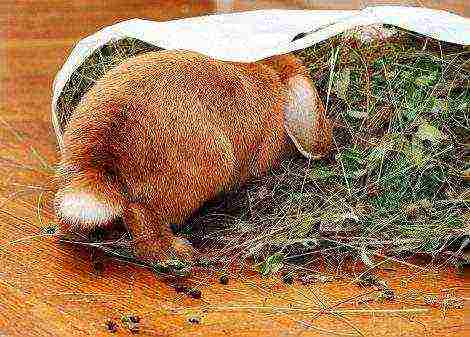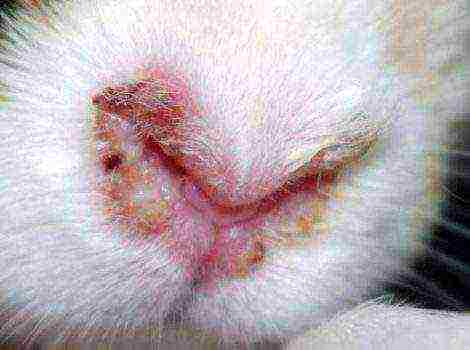Content
- 1 How long is pregnancy in rabbits and how to give birth?
- 1.1 How to tell if rabbits are pregnant
- 1.2 How long does it bear and how long does it lamb?
- 1.3 How to take care of a pregnant rabbit?
- 1.4 Preparing the cage for the period of labor in time
- 1.5 Signs of an approaching birth by rabbits
- 1.6 Does a person need help during childbirth and how many days does a rabbit give birth?
How long is pregnancy in rabbits and how to give birth?
When mating is successfully completed and the rabbit becomes pregnant, a period of waiting for cubs begins. At this time, rabbit breeders have many questions about how to take care of the rabbit before and during childbirth, how long the pregnancy lasts and how to help her. It is impossible to predict possible risks, but to reduce it really, providing the female with the necessary living conditions.
In this article, we will analyze the main questions: how long pregnancy lasts in rabbits, how to recognize it, how to care for a pregnant rabbit and how to help the female in childbirth.
How to tell if rabbits are pregnant
It is possible to determine whether a female is pregnant or not in several ways 2 weeks after mating with a male.
With your fingertips, you need to feel the fruits in the female's stomach, they feel like a chain of balls... You need to be careful so as not to harm the kids. The rabbit should be grasped by the ears and scruff with the right hand, and with the left grab between the hind legs from below. Place your thumb on your right side and your other fingers on your left. If pregnancy has occurred, then it will be possible to grope for the embryos in the abdomen.
For comparison, before this it is worth checking the rabbit, which is not expecting offspring. If you did not have to carry out the manipulation earlier, there is no confidence in your actions, it is better to contact the veterinarian so that the lives of the rabbits are not in danger.
Other common signs:
- Aggression. The male is taken to the rabbit and watched at her behavior. Pregnant women do not accept courtship, growl at the male, run after him around the cage. Sometimes females do not refuse to re-act. Often, rabbits in position bite the owner, do not allow them to touch themselves. This is due to the inclusion of the maternal instinct. Others, on the contrary, behave calmly, hide in a house, avoid contact with people.
- Roundness. About a week after covering, the female's belly begins to round up, but this may not be noticed under the layer of fluff. Closer to childbirth, it is difficult for rabbits to walk, they become like a ball, mostly lie.
- Nesting... It is necessary to put some hay in the cage and see what the rabbit does with it. The pregnant female will take it in her teeth and begin to equip the nest. By the same principle, rabbits pluck the fluff out of their belly before giving birth.
- Diet changes. While waiting for the baby, females often begin to drink a lot of fluids and eat, their taste preferences change. So, the rabbit can defiantly throw out her usual food from the feeder, showing by this that she wants something else. But such changes usually happen in the first week of waiting for the baby, then everything falls into place.
This condition, when mating was not completed successfully, a corpus luteum appeared in place of the ovarian follicle. About 2.5 weeks after crossing, the female behaves like a pregnant woman. If after this time the activity decreases, the rabbit is ready to mate again, then we can talk about the falsity of the process. This is due to the low vitality of the partner's sperm, as well as when the female gives birth without interruptions between pregnancies. And then let's talk about how many bunnies bears bunnies in time.

How long does it bear and how long does it lamb?
So how long does a rabbit's pregnancy last? Rabbits begin to mate at the age of 3-5 months. The gestation period is 28 to 35 days, mostly about a month (30–31 days). The term depends on the breed of rabbits, the number of cubs, the age of the animal.
Rabbits of large breeds (flanders, giants) go pregnant longer, small ones (decorative) give birth faster. The more embryos in the abdomen of the uterus, the faster they will be born. Young rabbits give birth to about 4–5 babies at a time, their period of gestation is longer than that of experienced individuals.
Toxicosis can both greatly disturb the individual and proceed with mild symptoms. Frequent manifestations of toxicosis are:
- difficulty breathing;
- frequent urination;
- depressed state;
- malfunctions of the central nervous system;
- the smell of acetone from the mouth.
How to take care of a pregnant rabbit?
As we already mentioned, the gestation period in rabbits lasts an average of 30 days. The female needs to provide peace of mind by isolating her from other rabbits, external stimuli (noise, bright light). It is easy to scare a pregnant individual, which can provoke a miscarriage.
After giving birth, the male must be transplanted, otherwise he can injure the babies and fertilize the rabbit again. During gestation, special attention should be paid to the diet and living conditions of the expectant mother.
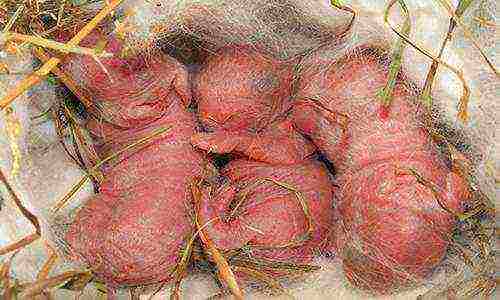
Nutrition for a pregnant woman
There should always be water in rabbit cages, especially during the nesting period. At this time, the female is thirsty; in case of strong thirst, she can eat the cubs. The diet must be varied and included in it:
- fresh vegetables such as beets, carrots, cabbage;
- cereal and hay from herbs;
- vitamin supplements such as vitamins C, D, fish oil.
With a poor diet, the female will have problems with milk, the babies will be born weakened.
You may be interested in the following posts on the topic of rabbits:
- Keeping rabbits at home.
- Caring for decorative rabbits.
- Symptoms and treatment of coccidiosis in rabbits.
Preparing the cage for the period of labor in time
In the rabbit house, ventilation is provided, while preventing drafts. High temperatures, bright light must also be excluded. Do not forget about hygiene, it is better to do cleaning at times more often than usual. About 5 days before giving birth, a baby nest should be placed in the cage.
The rabbit's dwelling should be disinfected so that infections are not scary for her and her offspring. For processing, you can use a special disinfectant or hot water with potassium permanganate. After applying the first one, the cage must be rinsed with hot water.
A great homemade nest will come out of a cardboard box. It should be about 10 cm longer than the female in the supine position. If it turns out differently, then the rabbit will not understand the purpose of this structure. An exit with a threshold for the rabbit should be cut on one side of the nest. It is necessary to make sure that the female can go in and out, and the litter and babies do not fall out.
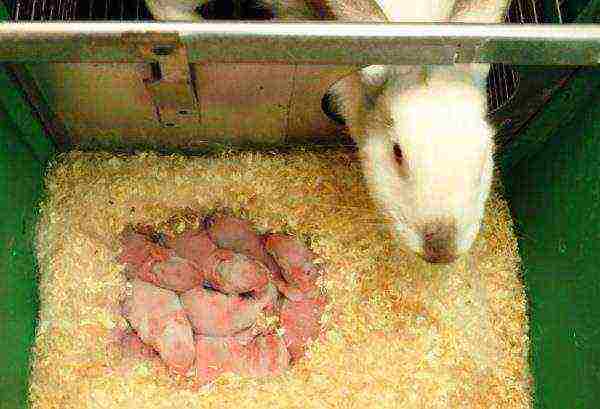
You need to put clean soft hay in the finished nest, leave some in the cage.So the rabbit will be able to arrange the place for the kids to her liking. Instead of hay, sawdust, shavings, pieces of newspaper are used.
Signs of an approaching birth by rabbits
What is the gestational age in rabbits we have analyzed. The female carries cubs for about 1 month. The last week of bearing offspring is especially difficult for females. They should not be allowed out for a walk. Efforts of a person, a rabbit, should be aimed at improving the cage and nest for future offspring. It is possible to judge that the cubs will be born from day to day by the following signs:
- Rabbits are nervous, behave aggressively towards other individuals and people.
- Sometimes the state of females is too calm before the birth of babies, they climb into a dark corner and sit quietly there. This is not a deviation from the norm.
- The female again begins to actively eat and drink plenty of fluids.
- The expectant mother makes a nest a few days before the birth. She moves the hay to the baby area and spreads it out. There she spreads her fluff from her belly and chest.
If the female nibbles the fluff, but does not take it to the nest, it should be carefully moved there. When the rabbit tears the fluff long before giving birth, you should clean it up so that it does not get clogged, and later put it back in the cage. Such mothers require attention to themselves, most likely they will not properly care for their offspring.
Does a person need help during childbirth and how many days does a rabbit give birth?
Rabbit lambing often occurs at night or in the morning, rarely during the day. The process takes 10-60 minutes, but it can take several minutes, more than an hour. Females usually give birth without outside help, you just need to control the process, checking whether everything goes without problems every 10 minutes. If the rabbit cannot give birth to large cubs or if there are other difficulties, then the help of a veterinarian is needed.
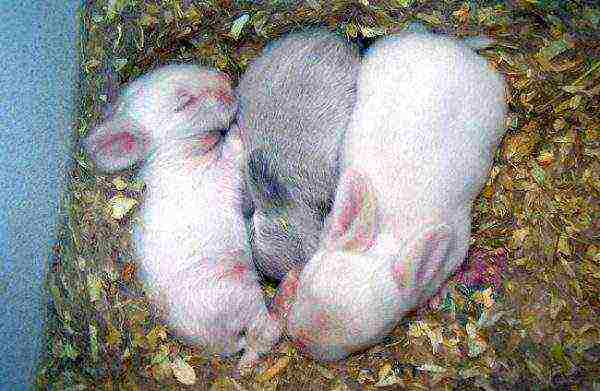
But how many rabbits does a rabbit give birth to? Up to 15 young rabbits can be born, it will not work to guess the exact figure before giving birth. Usually there are 5–8 babies in litters, but young females can give birth to 3–4 cubs.
Rabbit breeders ensure that babies are not born on the floor. If this happens, the rabbit must be placed in another cage, wipe the hands with the fluff from the nest and put the cubs there, covering it from above. The female must be returned no earlier than after 20 minutes so that the human smell disappears.
Ideally, after giving birth, the rabbit licks her cubs, covers them with fluff in the nest and feeds them. But if she behaves differently (throws, tramples the rabbits, shows aggression towards them), you can provide the babies with a heating pad and plant the female only for feeding.
If this does not work out, then the cubs will have to be transplanted to other females. To do this, they are cleaned of the old fluff, rubbed with fluff from the new nest and put into a calm and mature female.
When the rabbits are in the nest well-fed and warm, you should not disturb the mother, this will make her nervous. You can pick up the cubs when they are covered with wool and begin to crawl out of the nest.
Rabbit breeders receive healthy rabbits from individuals, which will soon multiply offspring. But pregnancy and childbirth of a female require moral, practical training from a person. He must pay attention to the rabbit and the newborn and follow the rules of care that apply to them.
Now you know how much a pregnant rabbit walks and how to correctly determine her interesting position.
Finally, we suggest watching an interesting video on the topic:
